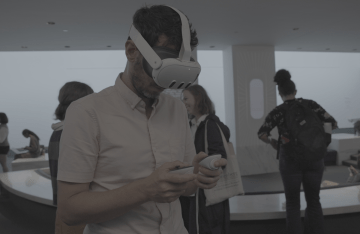A Road Map To Reduce Firearm Harms by 2040
Three Penn faculty members, including PIK Professor Desmond Patton, are among more than 40 experts to author a report addressing the persistent challenge of gun violence and proposing solutions stemming from a JAMA Summit convened last spring.

Since the start of 2021, more than 800,000 people have died from firearm-related injuries in the United States, and over two million have been injured. Recognizing the persistent challenge of gun violence, JAMA and JAMA Network convened a JAMA Summit in March 2025, bringing together thought leaders from medicine, public health, law, industry, and community violence intervention with a singular focus: to chart an innovative road map that will lead to substantial reductions in firearm violence, injuries, and harm in the U.S. by 2040.
JAMA published a “blueprint for action” that summarizes discussions from the Summit: JAMA Summit Report on Reducing Firearm Violence and Harms. Three faculty members from the University of Pennsylvania are among the report’s co-authors: Therese S. Richmond of the School of Nursing, Anthony A. Braga, of the School of Arts & Sciences, and PIK Professor Desmond Patton of the School of Social Policy & Practice and Annenberg School for Communication with a secondary appointment in the Perelman School of Medicine.
The report synthesizes a rich evidence base on policies and interventions that demonstrably reduce firearm violence and deaths. The authors address state laws on handgun purchaser licensing and safe firearm storage, strong domestic violence restraining orders and removal policies, extreme risk protection orders, community violence intervention programs, environmental changes (i.e., greening vacant lots and improving street lighting), and collaborative, focused policing.
"Firearm injury is a profound and preventable public health crisis that demands more than singular solutions. This JAMA Summit report provides a vital, evidence-based road map—informed by experts across fields—that charts a practical path toward dramatically reducing harm by 2040,” says Richmond. “As a nurse scientist, I recognize the immense human toll and am committed to implementing the actionable, systemic changes needed to make our communities safer."
"This report names the drivers of harm and the levers to change them, turning concern into action. And for Philadelphia, it sets shared standards and timelines so city agencies, schools, health systems, and neighbors can move in step," adds Patton. "Emerging tech and AI have a role here—as accountable tools with transparent methods, community oversight, and measures that improve safety without expanding surveillance."
The authors pinpoint five essential actions to drive progress in the coming years:
- Invest in community-based initiatives and address upstream drivers like housing, opportunity, and mistrust.
- Advance technologies such as biometric “smart guns,” passive detection systems, and safety tools driven by artificial intelligence, while strengthening oversight for firearms as consumer products.
- Shift public and policymaker understanding about the preventability of firearm harms, reframing gun violence as a public health, social, and environmental issue.
- Support coordinated action at federal, state, and local levels informed by scientific insight and advocacy.
- Expand research on the effectiveness, scaling, and equity of interventions—from basic science to agent-based modeling and community impact assessment.
JAMA Summit convenes leaders across disciplines and sectors to propose innovative, actionable steps addressing urgent health challenges. Outcomes include special communications, policy recommendations, and a growing library of multimedia resources designed to catalyze broader discussion and action.
Anthony A. Braga is the Jerry Lee Professor of Criminology in the Department of Criminology in the School of Arts & Sciences at the University of Pennsylvania.
Desmond Upton Patton, a Penn Integrates Knowledge University Professor and the Waldo E. Johnson Jr. Professor, is the founding director of SafeLAB. He has appointments in the School of Social Policy & Practice and Annenberg School for Communication with a secondary appointment in the Perelman School of Medicine at Penn.
Therese S. Richmond, a professor in in the Department of Biobehavioral Health Sciences in Penn’s School of Nursing.
Other authors include DeVone Boggan of Advance Peace; Frederick Chen of the American Medical Association; Michael R. Ulrich of Boston University School of Public Health; Nick Wilson of Center for American Progress; Charles C. Branas of the Columbia University Mailman School of Public Health; Jonathan D. Quick and Eszter Rimanyi of Duke Global Health Institute and Harvard Medical School; Anil Chitkara of Evolv Technology; Zirui Song of Harvard Medical School; David Hemenway of Harvard T.H. Chan School of Public Health; Robert Sampson of Harvard University; Joseph S. Ross of JAMA; Lindsay Dawson of JAMA and the JAMA Network; Adam Seth Levine of Johns Hopkins; Cassandra Crifasi and Daniel Webster of Johns Hopkins Bloomberg School of Public Health; Joseph V. Sakran of Johns Hopkins School of Medicine; Terri A. deRoon Cassini and Stephan Hargarten of the Medical College of Wisconsin; Roger L. McCarthy of the National Academy of Engineering; Magdalena Cerdá of NYU Langone Health; Nancy La Vigne of Rutgers School of Criminal Justice; Dimitri A. Christakis of the Seattle Children's Research Institute; Shani A.L. Buggs of UC Davis; Rochelle Dicker of University of California, San Francisco; Jens Ludwig of the University of Chicago Crime Lab; Laura Vargas of the University of Colorado School of Medicine; Nason Maani of the University of Edinburgh; Sheena Ereye and Joseph Richardson Jr. of the University of Maryland; John Z. Ayanian of the University of Michigan; Marc A. Zimmerman of the University of Michigan Institute for Firearm Injury Prevention; Frederick P. Rivara and Ali Rowhani-Rahbar of the University of Washington; Sandro Galea of Washington University School of Public Health; Robert B. Wilcox of Washington D.C.; Jennifer Tucker of Wesleyan University; and Megan L. Ranney of the Yale School of Public Health.



